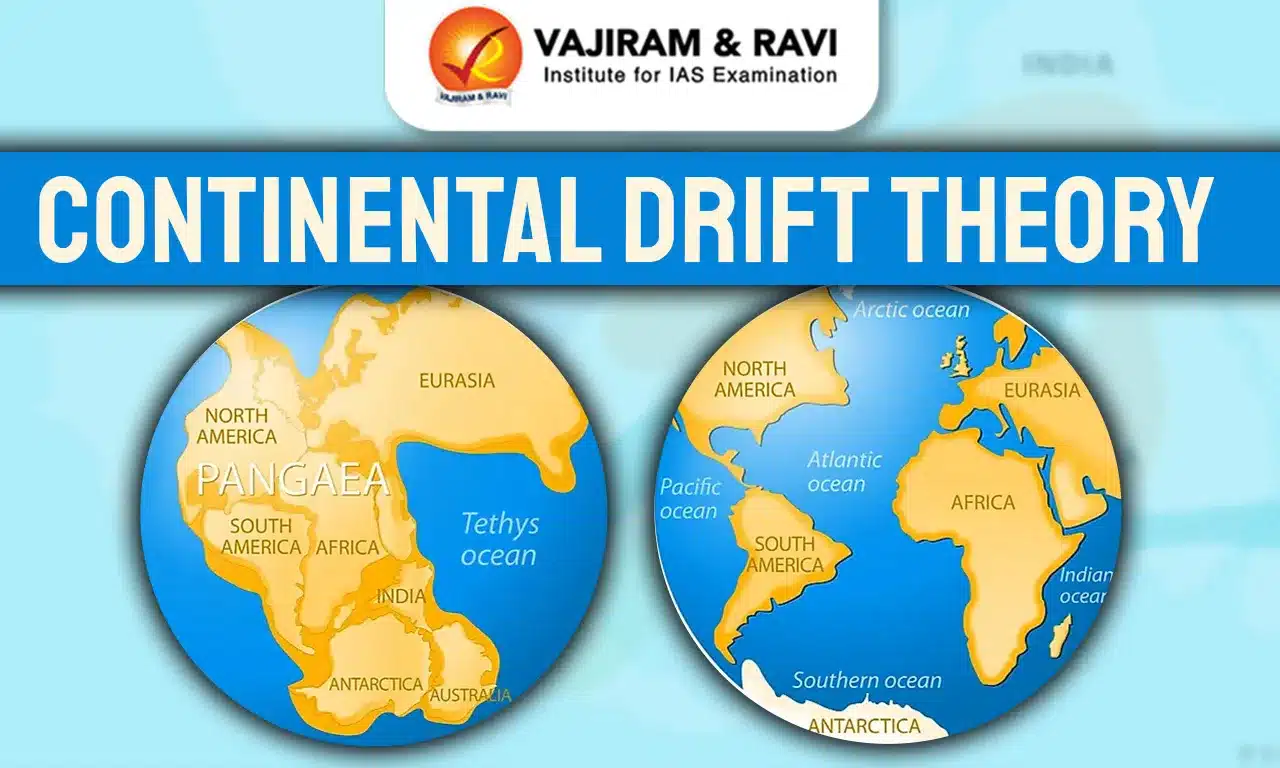The Continental Drift Theory, proposed by Alfred Wegener in 1912, revolutionized our understanding of Earth's geological history. It posits that continents were once united in a supercontinent called Pangaea and have since drifted apart over geological time.
Initially met with skepticism, Wegener's hypothesis laid the foundation for the modern theory of plate tectonics, which explains continental movement through processes such as mantle convection, ridge push, and slab pull.
About Continental Drift Theory
The Continental Drift Theory was first hinted at by Abraham Ortelius in 1596, but it was not until 1912 that the idea gained significant traction. German meteorologist Alfred Wegener provided a comprehensive explanation, proposing that a supercontinent, Pangaea, began to break apart around 200 million years ago, leading to the continents' current positions.
Development Through Plate Tectonics:
- Despite the compelling evidence Wegener presented, his theory lacked a mechanism for the movement of continents.
- This gap was addressed in the mid-20th century with the advent of the plate tectonics theory. This theory explained how Earth's lithosphere is divided into tectonic plates that glide over the semi-fluid asthenosphere.
- Key processes such as mantle convection, ridge push, and slab pull were identified as the forces driving these movements.
Alfred Wegener
Continental Drift Theory was introduced by Alfred Wegener, who is credited with the formal development of the Continental Drift Theory (also known as Wegener's hypothesis), which he first presented in 1912. Wegener proposed that the continents were once part of a single supercontinent called Pangaea, which began to break apart about 200 million years ago.
- Continental Drift Concept: He suggested that the continents drifted through the oceanic crust, forming the present-day configuration of continents.
- Evidence Supporting Theory: Wegener's theory was based on various forms of evidence, including the fit of the continents, similarities in rock formations and fossil records across different continents, and paleoclimatic data.
- Lack of Immediate Acceptance: Despite the compelling nature of his evidence, Wegener's theory was not widely accepted during his lifetime due to a lack of a plausible mechanism for how continents could move.
Continental Drift Theory Forces for Drifting
Alfred Wegener initially hypothesized that continents moved through the Earth's crust due to centrifugal force and tidal pull from the Earth's rotation and gravitational interactions with the Moon and Sun. However, these forces were deemed insufficient for moving large land masses. The actual mechanism for continental drift was later explained by the theory of plate tectonics, which identifies specific forces responsible for the movement of tectonic plates and the drifting of continents.
Modern Mechanisms: The theory of plate tectonics identified more plausible forces:
- Mantle Convection: Heat from Earth's interior creates convection currents in the asthenosphere, which drag tectonic plates along the surface.
- Ridge Push: New crust forms at mid-ocean ridges as magma rises and cools. The resulting density differences cause plates to slide apart.
- Slab Pull: In subduction zones, denser oceanic plates are pulled beneath lighter continental plates, driving plate movement.
- Gravity: Gravity contributes to the sinking of denser lithospheric material into the mantle at subduction zones.
Continental Drift Theory Evidence
Wegener and others provided key evidence for continental drift theory, including the jigsaw-like fit of continents, matching rock formations, tillite deposits from past glaciation, similar placer deposits across continents, and shared fossils, supporting the idea that continents were once part of the supercontinent Pangaea. Following are the details of continental drift theory evidence:
Jigsaw Fit of Continents
One of the most striking pieces of evidence is the jigsaw-like fit of continental coastlines. For example, the eastern coast of South America aligns almost perfectly with the western coast of Africa. Similar fits can be observed between other continents, such as North America and Europe, as well as Antarctica and Australia.
Geological Evidence
- Rock Formations: Similar rock types and structures are found on continents now separated by vast oceans.
- For instance, the Appalachian Mountains in North America align geologically with the Caledonian Mountains in Scotland and Scandinavia.
- The matching ancient rock belts between Brazil and Western Africa are a well-documented geological evidence of continental drift. These rocks share identical age, composition, and structure, supporting the idea that South America and Africa were once joined.
- Tillite Deposits: Sedimentary rocks formed from glacial till, known as tillite, have been discovered in regions like South Africa, India, Australia, and South America. These deposits indicate a shared glacial history, suggesting these continents were once connected and located near the South Pole.
- For example, the Gondwana sedimentary system found in India is also found in other southern landmasses like Africa, South America, Antarctica, and Australia, providing strong evidence of past continental connection.
Fossil Evidence
The distribution of fossils across continents provides compelling evidence for continental drift:
- Mesosaurus: Fossils of this freshwater reptile are found in both South America and Africa, indicating these continents were once joined.
- Glossopteris: Fossils of this plant species are distributed across South America, Africa, India, Antarctica, and Australia, supporting the idea of a southern supercontinent.
- Lystrosaurus: Fossils of this land-dwelling reptile are found in Africa, India, and Antarctica, further affirming past continental connections.
Paleoclimatic Evidence
- Glacial Deposits in Tropical Regions: Evidence of ancient glaciation, such as tillite, is found in present-day tropical areas, suggesting these regions were once located closer to the poles.
- Placer Deposits: Geological studies suggest that the gold deposits in Ghana might have originated from the Brazilian Plateau, which aligns with the theory that the continents were once connected.
Significance of Continental Drift Theory
The Continental Drift Theory transformed the field of geology by explaining phenomena such as earthquakes, volcanic activity, and the formation of mountain ranges. It also provided a framework for understanding the historical distribution of species, climatic shifts, and the dynamic nature of Earth's surface.
While initially criticized for lacking a credible mechanism, the Continental Drift Theory gained acceptance with advancements in geophysics and seafloor mapping. Modern evidence from satellite data, magnetic anomalies, and seafloor spreading has validated Wegener’s groundbreaking hypothesis.
Continental Drift Theory UPSC PYQs
Question 1: What do you understand by the theory of continental drift? Discuss the prominent evidence in its support. (UPSC Mains 2013)
Question 2: Which of the following are the evidences of the phenomenon of continental drift? (UPSC Prelims 2025)
- The belt of ancient rocks from Brazil coast matches with those from Western Africa.
- The gold deposits of Ghana are derived from the Brazil plateau when the two continents lay side by side.
- The Gondwana system of sediments from India is known to have its counterparts in six different landmasses of the Hemisphere. Southern
Select the correct answer using the code given below.
a) 1 and 3 only
b) 1 and 2 only
c) 1, 2 and 3
d) 2 and 3 only
Ans: (c)
Last updated on December, 2025
→ Check out the latest UPSC Syllabus 2026 here.
→ Join Vajiram & Ravi’s Interview Guidance Programme for expert help to crack your final UPSC stage.
→ UPSC Mains Result 2025 is now out.
→ UPSC Notification 2026 is scheduled to be released on January 14, 2026.
→ UPSC Calendar 2026 is released on 15th May, 2025.
→ The UPSC Vacancy 2025 were released 1129, out of which 979 were for UPSC CSE and remaining 150 are for UPSC IFoS.
→ UPSC Prelims 2026 will be conducted on 24th May, 2026 & UPSC Mains 2026 will be conducted on 21st August 2026.
→ The UPSC Selection Process is of 3 stages-Prelims, Mains and Interview.
→ UPSC Result 2024 is released with latest UPSC Marksheet 2024. Check Now!
→ UPSC Prelims Result 2025 is out now for the CSE held on 25 May 2025.
→ UPSC Toppers List 2024 is released now. Shakti Dubey is UPSC AIR 1 2024 Topper.
→ UPSC Prelims Question Paper 2025 and Unofficial Prelims Answer Key 2025 are available now.
→ UPSC Mains Question Paper 2025 is out for Essay, GS 1, 2, 3 & GS 4.
→ UPSC Mains Indian Language Question Paper 2025 is now out.
→ UPSC Mains Optional Question Paper 2025 is now out.
→ Also check Best IAS Coaching in Delhi
Continental Drift Theory FAQs
Q1. What is the theory of continental drift?+
Q2. Who gave the continental drift theory?+
Q3. What are the 4 evidences of continental drift theory?+
Q4. Why was continental drift rejected?+
Q5. What was the first supercontinent?+

















